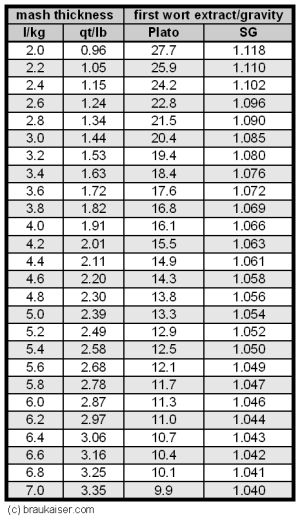pacebrew
Well-Known Member
probably diluted, sometimes wheat is just very problematic without a protein rest.

Then how is it that I get good efficiency batch sparging without stirring or waiting between filling and draining?

Second, I think you could benefit from checking the gravity of your mash. All you do is mix well before taking the first runnings, and get a gravity sample from the first runnings. By knowing your mash thickness (in qts per lb) and mash gravity, you can figure out the percentage of conversion from this simple chart, reproduced from Kaiser's website:
...
At 1.25 qts per lb, your first runnings should be at a gravity of about 1.096, give or take. If it's very low, then you have problems with conversion or the quality of the crush.
If you find you're getting adequate conversion efficiency, then you need to look to your sparging process. If your conversion efficiency is not good, then you need to look at the crush of the grain and your water chemistry.






![Craft A Brew - Safale S-04 Dry Yeast - Fermentis - English Ale Dry Yeast - For English and American Ales and Hard Apple Ciders - Ingredients for Home Brewing - Beer Making Supplies - [1 Pack]](https://m.media-amazon.com/images/I/41fVGNh6JfL._SL500_.jpg)





How fast are you draining?? If you sparge to fast you'll get crappy eff. My flow is about a quart/quart and a half per min.
I came up with 43% after correcting for the 75F temp at measurement. I don't know if that makes you feel better or not but I usually plan on 60% eff when wheat is my base malt.